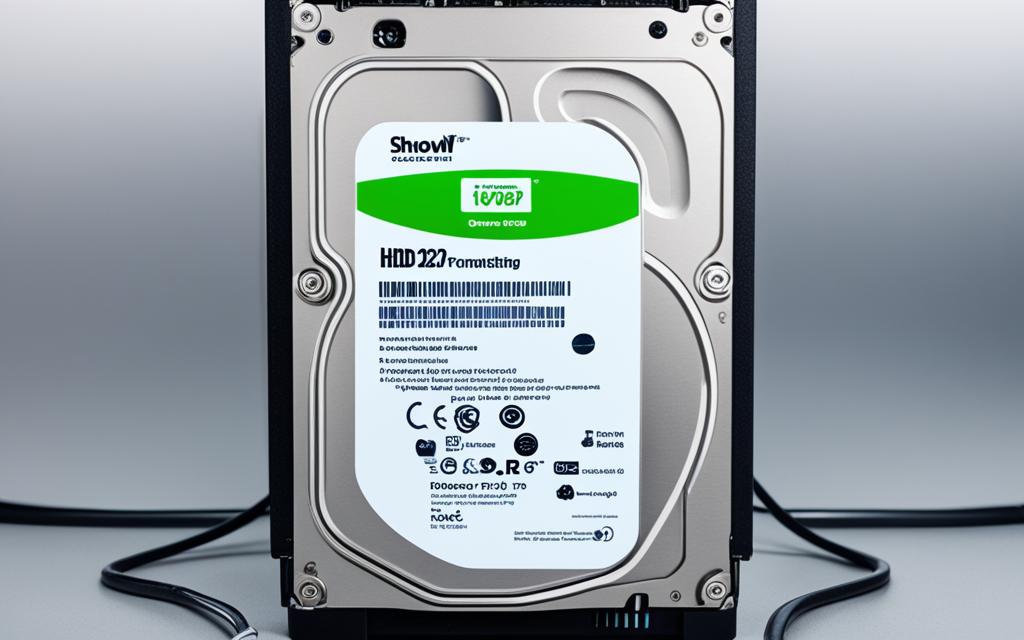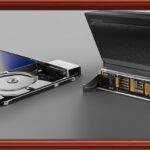Table of Contents
Formatting a hard drive helps it work better with many devices. FAT32 is a good choice for both external hard drives and USBs. It makes your storage work well. Drives under 32GB fit FAT32 easily. Yet, bigger ones may need different ways1.
In this guide, we’ll show you how to make your HDD FAT32. This way, you can use your storage well and keep your digital world organised.
Key Takeaways
- Formatting to FAT32 allows for enhanced compatibility with a range of devices.
- External hard drives larger than 32GB often require alternative file systems for optimal performance.
- Understanding FAT32 limitations is essential for managing file sizes effectively.
- Utilising third-party software can help overcome FAT32 formatting restrictions on larger drives.
- Always back up your data prior to initiating the formatting process.
Understanding FAT32 and Its Benefits
FAT32, or File Allocation Table 32, is a popular file system. It’s known for working well with many operating systems and devices. It came out with Windows 95 in 1996. Even today, its way of managing data storage stands out. FAT32 lets you make partitions up to 2 terabytes. It also deals with individual files up to 4 gigabytes2. This makes it a strong choice when compared to others like NTFS and exFAT. Its versatility is a key highlight in any file system comparison.
What is FAT32?
FAT32 supports all operating systems after MS-DOS 7.0. This includes different versions of Windows, Linux, and macOS3. It makes sharing files between devices like USB flash drives and digital cameras easy. FAT32’s default sector size is 32 MB. It can create drives up to 16 TB using larger clusters. For instance, a 6 TB hard drive formatted to FAT32 will have about 5.45 TB of usable space3. This shows its efficiency in handling storage.
Advantages of Using FAT32
FAT32 is great for working with smaller file sizes. It also shines when you need compatibility across diverse devices. It manages data effectively, especially for files up to 4 GB. This covers many multimedia files and smaller apps. Its support for older devices and software is another plus. This makes it useful in many different situations where newer systems might not work. Additionally, FAT32 has basic security features like data encryption. This helps keep sensitive files protected3.
Preparing Your HDD for Formatting
Before you start formatting an HDD, it’s essential to get ready properly. First, make sure all your data is backed up. This is because formatting wipes out everything on the drive. It’s key to keep your data safe to avoid losing anything important.
Back Up Your Data
It’s critical to back up your data before formatting, as you will lose it all. Use secure methods like cloud storage, external hard drives, or software. This ensures your data stays safe, giving you peace of mind while formatting.
Check Drive Size and Limitations
Knowing your drive’s size limit is important before formatting. FAT32 won’t work with drives over 2TB, and Windows limits FAT32 partitions to just 32GB. For drives around 1TB, consider third-party tools like EaseUS Partition Master45. They help avoid these limitations and make formatting smoother.
Always check your drive’s specs to steer clear of problems. Make sure they match with FAT32’s requirements, including the 4GB file size limit6. Confirm your specs by visiting how to check computer specs for more help.
How to Format a HDD to FAT32
Formatting a hard drive to FAT32 can be done in different ways. This lets users pick the best method for them. Each approach has its benefits, fitting various needs and drives.
Using Windows File Explorer
To format a drive easily, use File Explorer. This way is good for drives smaller than 32GB. First, connect your drive and open File Explorer. Right-click on the drive and choose ‘Format’. Then, select FAT32 and click ‘Start’. This method is simple, even for beginners.
Using Command Prompt
The Command Prompt is great for those who know their way around. You can format quickly with the right commands. Make sure you pick the correct drive to avoid losing data. Remember, FAT32 has a 4GB file size limit. Formatting big drives takes time and patience17.
Utilising Third-Party Software
For an easier experience, third-party software like EaseUS Partition Master helps. These programs offer a user-friendly way to format. They work well with larger drives and keep your data safe. A few clicks and your drive is formatted, perfect for those new to formatting87.
In conclusion, you can format with File Explorer, format using Command Prompt, or use third-party software for FAT32. Each option has its pros. Follow the steps carefully and check your choices for a smooth formatting187.
Common Issues and Troubleshooting
Formatting a drive to FAT32 can bring up several problems. One major hurdle is dealing with larger drives, especially those over 32 GB. Troubleshooting FAT32 format issues emerges mainly because FAT32 struggles with handling large storage capacities. This means drives bigger than this limit don’t fit well with FAT32. Many usual formatting tools fail with these larger drives. Users often turn to third-party tools or the Windows Command Prompt for help9.
Unable to format larger drives
Windows 10 usually stops you from formatting large drives to FAT32. This is because of drive limitations. Issues like file system problems, bad sectors, or too many partitions might be behind it10. Faced with these format problems, looking into alternative approaches can be useful. Tools for managing partitions or setting up new FAT32 partitions might help9. But remember, formatting large drives through the command prompt can be slow. Sometimes, it takes as long as five hours10.
Dealing with Bad Sectors
Bad sectors on a drive can also throw a spanner in the works. Using tools like chkdsk can pinpoint and fix disk errors. These errors might stop you from formatting and even corrupt your data. Regular checks and using reliable recovery tools are essential. A tool like Recoverit by Wondershare works wonders with a success rate of about 96%10. Together, these steps help combat the hurdles of troubleshooting FAT32 format issues.
Conclusion
In this summary of HDD formatting, we’ve looked at how to format a hard drive to FAT32. We stressed the key steps of prep and getting it done. It’s important to know that FAT32 is easy to use and works with many devices. But it can’t handle files over 4GB or partitions over 32GB.
Many new hard drives, like the 500GB versions from WD and Toshiba, are too big for FAT32. That’s important to remember if you’re planning to format a larger drive.
Tools like AOMEI Partition Assistant help make formatting simpler. They let you format bigger drives without losing data. This shows how choosing the right tool matters depending on what your device needs.
Knowing about these tools and how to use them means you can make the most of your hard drives and USB sticks. As we wrap up, keep in mind that smart formatting choices can really affect how well your device works11. Understanding each step makes handling different file systems and storage sizes smoother1213.
FAQ
What is the FAT32 file system?
FAT32, developed by Microsoft in 1996, is a system for storing files efficiently. It works across different operating systems. FAT32 can handle drives up to 2 terabytes and files as large as 4 gigabytes.
What are the primary advantages of using FAT32?
FAT32 works well with many devices and operating systems. It’s good at managing small files. Also, it offers fast transfer speeds on drives smaller than 32 GB. This makes it perfect for sharing drives between various devices.
How do I prepare my hard drive before formatting to FAT32?
Start by saving all important data elsewhere. Make sure your drive doesn’t exceed FAT32’s size limits. Remember, formatting will delete everything on the drive.
What methods can I use to format a hard drive to FAT32?
For drives under 32 GB, use Windows File Explorer. The Command Prompt is a more manual option. Alternatively, use tools like EaseUS Partition Master for a simpler process with a graphical interface.
What should I do if I cannot format a larger drive to FAT32?
If you have a larger drive, consider using exFAT instead. It’s better for bigger file sizes and partitions than FAT32. Understanding FAT32’s limits is key to avoiding problems.
How can I deal with bad sectors on my hard drive?
To fix bad sectors, use Windows’ CHKDSK tool to find and repair them. Do this before you try formatting the drive again.
Why is data backup critical before formatting?
Backing up data is vital because formatting erases everything on a hard drive. By saving your files elsewhere, you don’t risk losing them during the formatting process.
Source Links
- https://www.easeus.com/partition-master/format-external-hard-drive-fat32.html – How to Format External Hard Drive to FAT32 on Windows 10? [FAT32 Guide]
- https://www.coursera.org/articles/fat32 – What Is FAT32?
- https://recoverit.wondershare.com/file-system/fat32-file-system.html – FAT32 File System – Definition, Uses, Pros&Cons, and More
- https://www.easeus.com/partition-master/format-1tb-hard-drive-to-fat32.html – How to Format My 1TB Hard Drive to FAT32? 2024 Guide for Beginners
- https://www.avg.com/en/signal/how-to-format-hard-drive – Ultimate Guide: How to Format a Hard Drive
- https://www.idiskhome.com/resource/backup/format-external-hard-drive-to-fat32-in-windows-10.shtml – Format FAT32 Windows 11/10: How to Format HDD/External Hard Drive to FAT32 – Qiling
- https://www.wikihow.com/Format-an-External-Hard-Drive-to-Fat32 – How to Format an External Hard Drive to Fat32 (with Pictures)
- https://community.wd.com/t/formatting-5tb-elements-hard-drive-to-fat32/263605 – Formatting 5TB elements hard drive to FAT32
- https://www.easeus.com/partition-master/format-usb-flash-drive-in-windows-10.html – How to Format to FAT32 in Windows 10 [Step by Step Guides]
- https://recoverit.wondershare.com/harddrive-tips/diskpart-format-hard-drive-to-fat32.html – How to Format Hard Drive to FAT32 in Windows with DiskPart
- https://www.diskpart.com/articles/format-500gb-hdd-to-fat32-3889.html – Easiest Way to Format 500GB External HDD to FAT32 in Windows 7/8/10
- https://www.diskpart.com/blog/how-to-format-hard-drive-larger-than-32gb-into-fat-32/ – How to Format Hard Drive Larger than 32GB into FAT 32? – AOMEI Partition Assistant Blog
- https://www.diskgenius.com/resource/format-ssd-to-fat32.html – How to Format SSD to FAT32 File System in Windows 11/10/8/7?








